I hope that through this blog, I have an engaging and engaged dialogue about art and arts management.
Don't wanna be here? Send us removal request.
Text
The All-American Immigrant

Yes, Alexander Hamilton. His name and face have popped up a lot recently. In large part thanks to Lin-Manuel Miranda and his smash hit musical Hamilton. I think I have officially become one of his groupies seeing him first in “In the Heights” both the Broadway musical and the Five Year reunion, and most recently in “Hamilton” at both The Public and on Broadway.
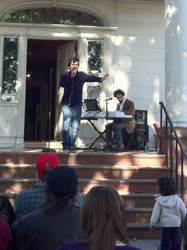
I still remember being Uptown at the Morris-Jumel Mansion (see image above) for a festival in the fall of 2013 and hearing him perform a few lyrics of his newest project. It was a wow moment even though rap and hip-hop were not my thing. I have been listening to the same playlists for years, and would rather go to a museum or travel than find new songs. Even my mom is way hipper than me; she already has Adele’s latest cd.
Like Lin, history has always been one of my favorite subjects and later on one of my majors in college. In junior high school I read Burr, the novel by Gore Vidal, just for fun. What a nerd; you are telling me!
Seeing Hamilton at The Public, I kept pinching myself. I truly, madly, deeply thought I was witnessing a part of musical history. My only advice if you are planning to go is to go with a full-tummy and fully caffeinated because it is a fast-paced ride through the early years of American history filled with lots of twists-and-turns, intrigue and of course love. My companions and I had no doubt it would go to Broadway. Later that evening, it was confirmed.
When I saw Hamilton on Broadway, it felt special. This was in part because the Richard Rodgers Theatre is simply beautiful. I felt lucky watching it a second time around because it helped me better appreciate all Hamilton did in such a short life. However, I felt like something got lost along the way. It made me think of a first kiss. It can´t be replicated.
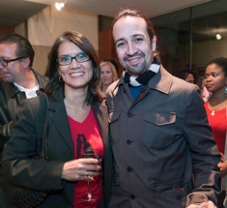
My last Lin sighting (so far) was at the end of the year when he and Sonia Manzano (Maria from Sesame Street) did a talk at the Skirball Center of NYU. It was terrific to see two Latino stars who have really paved the way. When I saw the sign promoting Hamilton: America Then America Now, it was a It was also a reminder of the themes that came up at “In the Heights” and again at “Hamilton;” issues of America’s identity and what made both musicals so powerful.
Making it and finding your own path as an Immigrant-American is what makes America great. Let’s not forget it when we cast our vote for the next president.
The Groupie wearing her Hamilton t-shirt with Lin-Manuel taken by Michael J. Palma
3 notes
·
View notes
Text
The Never Ending HiStory?!
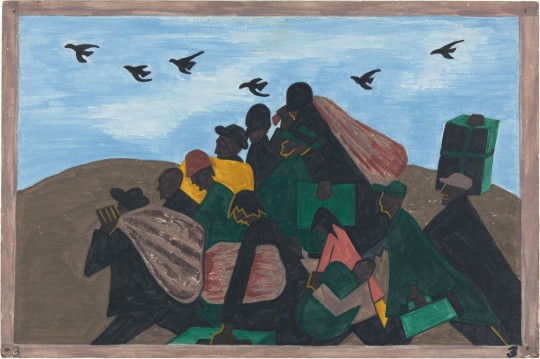
How often do things stay the same and how often do they really change? Visiting two great shows: One-Way Ticket and Presente! The Young Lords in New York, I am reminded that many, if not all, of the social issues these two exhibits reflect have changed little decades later. Today, on the heels of Michael Brown´s anniversary, it is hard to be optimistic.
One-Way Ticket (1941) is a series of 60 panels by artist Jacob Lawrence that showcase images of the African-American experience leaving the mostly rural south for the mostly urban north. The imagery is very modern with powerful lines and geometric shapes accompanied by very somber colors. There is a clear influence of Picasso, Matisse and Mondrian. But it also has a very personal and intimate look and feel with many metaphors. MoMA´s online tour does a great job in offering a historic context to what is known as the Great Migration. I was fascinated to learn that Lawrence, son of southern migrants, had not yet visited the south when he painted this series at the tender age of 23.
Decades later, in the late 1960´s, the Young Lords reflected a similar reality for Puerto Ricans in New York City. What began as a movement to pick-up uncollected trash in El Barrio and take-over of Lincoln Hospital in the South Bronx evolved into a political movement towards gender equality and Puerto Rican independence.
Although both exhibits offer background information, the Young Lords show with its three locations (El Museo del Barrio, Bronx Museum of Art and Loisaida Inc.,) provides a deeper look at the movement. However, at the root of both exhibits are the issues any household is concerned about: employment, health, education, food and housing. These themes come up sometimes subtly and often bluntly in photographs, posters, and other visuals.
It made me think of my former landlady, Mrs. Jefferson who moved from North Carolina to Brooklyn some thirty years ago. I would love to hear her oral history, her migration to New York. Just as many Irish Catholics had a photograph of President Kennedy in their living room, she had one of Obama. I can still remember crying tears of joy. Probably for the first time in my life, I felt truly proud to be an American. We had voted an African-American into the White House.
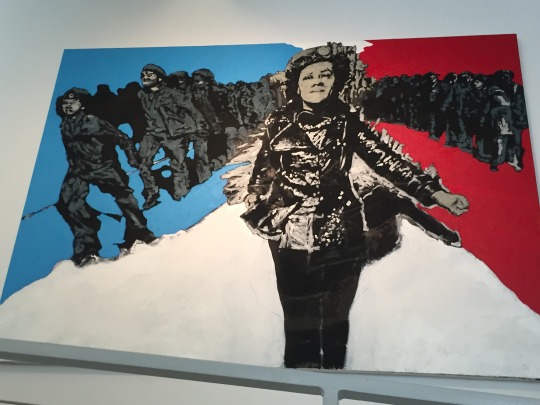
How will these issues that continue to plague our communities play out in the next election? Will our next president be the first woman or another member of a political dynasty? My hope is that we keep moving forward although history has proven that for every step forward, we often take two steps back.
Images: Top from One-Way Ticket & bottom Young Lords welcome panel at Bronx Museum
2 notes
·
View notes
Video
tumblr
So Far from God So Close to the US
After Donald Trump´s stupid remarks, I was reminded yet again that racism is very much alive. I was glad that several important American companies have stepped up and cut relations with him, and that one of his main concerns, his pocket, will be -even if mildly- affected. I was also glad that Latino celebrities spoke up too. Sadly though, no apologies have come forth by the Donald. As my grandmother Nanny Nanna used to say: he will get his. I like to call it karma.
So I thought it appropriate to share recent outings in the City connected to Mexican culture. A few weeks ago, I went to see Las Cafeteras (the Coffeemakers) at the Lincoln Center Atrium. The space is an unusual spot, a big hallway of sorts that offers free concerts. I had first heard of this group last summer during a national Latino workshop. For some reason I can´t remember now, I missed them but told myself I would not again this year. Never before had I seen a line so long for a performance there. Luckily, I bumped into a colleague and caught-up, met other people we knew until we finally made it inside.
Even though we made it in halfway through the concert, the wait was well worth it. They were amazing! The band members are first-generation Mexican-Americans who grew-up in or around East Los Angeles and have a very clear political influence. They describe themselves as old school music with new school stories. Audience participation is a must. At one point, one of the singers asked people to say what they would like Obama to do: the response that got the most reaction was a little girl´s comment: help innocent people who are in prison.
A few weeks before, I had attended my second Villalobos Brothers concert. For the past few years, they have offered summer concerts in their backyard. The three brothers born in Veracruz are classically trained musicians who blend elements of jazz and traditional Mexican rhythms. They call it high-octane Mexican fiddling. Known as the Marble Hill Summer Concert Series, these happenings are a fascinating blend of open mic mixed with social justice talk. My first time, I took my mom who was visiting from out of town. We started the night with a tequila shot (according to her, her first) and we waited and waited, until finally the show began. We had an African-American activist from the South, a Venezuelan intellectual turned Chavista, and lots of music. Ernesto Villalobos, also known as Ness, led with the violin. Anyone who wants to play an instrument, sing or recite is welcomed to participate. Did I also mention they sell yummy taquitos and other snacks?
This past weekend, my cultural adventures included a concert in the crypt of the Church of the Intercession in Washington Heights. Creepy. A little. And very cool too. This time, we heard Son Jarocho, beautiful and poetic storytelling music originally from Veracruz led by Zenin Zerefino & Friends. The second part of the evening was a fandango, which in Mexican lingo means a jam party. At first, I was a little confused because the only other time I heard fandango was in Spain. There, it is a style of flamenco music and dance.
All of a sudden the mood changed as it began to feel like a family gathering. The musicians and lead singer began forming a ¨c¨ surrounding a tarima or wooden box so that the dancers could show off their stuff. Once again a little girl stole the show. She had what I called ¨papitis¨. She did not want to let go of her papá. Soon enough she warmed-up and all of a sudden pointed towards the floor just as the Duchess of Alba had done in the painting by Goya. See video. I think it says it all.
So with all of this, what was my goal? Besides world peace, I really would like Trump to spend a year travelling around the country attending all sorts of cultural events and then appearing in an Apprentice series finale sharing with the audience how he became a little more cultured and less xenophobic. Wishful thinking? Perhaps. We have to start somewhere.
This entry is dedicated to Mexico & its people.
Title attributed to Mexican President Porfirio Díaz.
6 notes
·
View notes
Text
WaHi Oral Histories
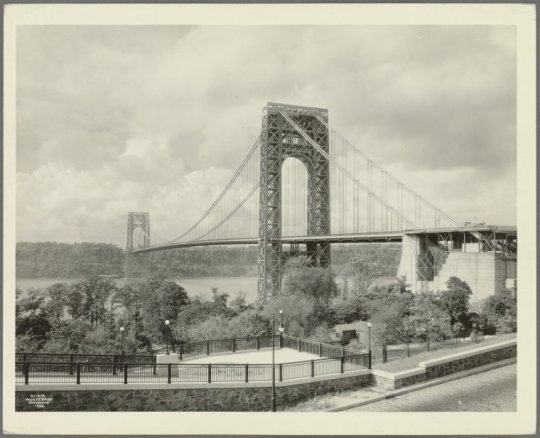
What started as a volunteer activity has since become a true life-learning experience. Since February, I have been a volunteer interviewer for The Oral History Project, a program of the New York Public Library (NYPL). The goal is to create a bank of stories of our community, Washington Heights-Inwood. As such, it will also serve as a reference for the public at large on different neighborhoods throughout the City.
So far, I have had the privilege to interview nine members of the community.
Octavio Felicie, super of my building. He moved to the neighborhood in 1968 from Puerto Rico.
Mino Lora, co-Executive Director & Program Director of People´s Theater Project. Her master´s thesis became her work.
Zead Ramadan, businessman. He grew-up in the community and became one of its biggest advocates.
Jimmy Nolan, Treasurer of the Inwood Little League. He has been involved with the organization for 50 years.
Led Black, writer, blogger & paradigm-shifter. He has lead a movement of bringing awareness that Uptown is a cool place to live, work, and play.
Polly Ferman, pianist and cultural entrepreneur. She has created several festivals including one with all-women tango performers.
Maggie Hernandez-Knight, visual artist and self-empowerment junkie. She became an entrepreneur by opening a movement studio.
Andrea Arroyo, visual artist and curator. Originally a dancer, her work has a keen feminist perspective.
Mario Tavarez, visual artist. He was involved with the Inwood Little League.
Hear their stories here: http://oralhistory.nypl.org/neighborhoods/washington-heights-inwood (some are in Spanish, some in English)
So why did I decide to do this volunteering, really? My selfish goal in doing these interviews has been to learn more about my neighbors. After living in Inwood for a little over two years, I still consider myself a newbie. Plus I like to ask (lots of) questions as well as listen to personal stories.
Last week, as part of the Uptown Arts Stroll (a month-long arts festival in June), I went to a talk at Word-Up Bookshop/Libreria Comunitaria with Led Black and Robert W. Snyder, author of Crossing Broadway. This book offers a fascinating view on politics and demographics and their repercussions on the neighborhood level. Much of what was talked and asked about by the audience had come up in my interviews too. History has come to life for me. Housing, gentrification, drugs, violence, parks, etc. help explain how many things have changed, but also how it has in some ways stayed the same.
Earlier in the week, I lead a Memory Circle at my library (Inwood Branch) on Uptown parks. Instead of having a 1-1 interview, the circle encourages participation from a group. We had seven neighbors who shared stories and anecdotes on our local parks that consist of 500 acres of parks north of 155th Street. One of my favorite stories was of a family burying ashes of a loved one in the caves of Inwood Park!
Before moving to Inwood, my goals in my neighborhoods had always been very practical or so I thought. Get to know the good places to shop, eat, and be friendly with the storeowners you frequent. Mind you, I don´t always fit in as my mom reminded me recently. This past Mother´s Day, my very Irish-looking mother walked side by side with her Latina-Americanized daughter through a very Dominican part of Washington Heights on our way to Marjorie Eliot’s Jazz Parlor. At one point, she said: I think we stick out. All I could say was: You think?
Afterwards, we both had to chuckle. Even when moments like this take place, my daily life is a much richer experience than it has been in a long time. I know more of my neighbors and a fair amount about the community’s history.
The Oral History Project ends in October, so my plan is to keep interviewing until then. In the meantime, I look forward to my next Memory Circle coming up!
Do you know about the history of your neighborhood?
Photo: George Washington Bridge.
#nypl#oralhistory#led black#polly ferman#journey space#inwoodlittleleague#andreaarroyo#peoplestheaterproject#wordup#washhts#inwood#nyc
8 notes
·
View notes
Photo
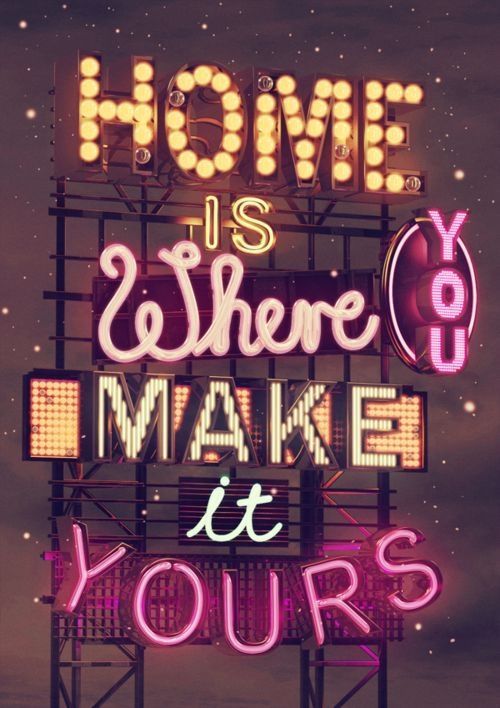
Home is where Mom Is. That was a magnet I gave her for Mother´s Day several years ago. Having different ¨homes¨ as a child and then again as an adult, home was also something very intimate and private. Few guests visited us growing up. Today, living in a roomier apartment with easy access to the subway, I continue to host few visitors, although my mom is one of my regulars. Maybe one explanation is food. Even after living in Inwood for a little over two years, I still miss my Brooklyn Food Co-op, a cult-like supermarket (as a friend likes to refer to it) with great fresh produce. My Saturday farmer´s market pales in comparison. The reason: lack of variety. At one point, I would cook and freeze enough to last me a month; now I barely cook enough for a meal. So hosting a dinner party becomes a major effort when before it was a piece of cake. Whether I eat out or make myself something to eat, I obsess about food all day long; I must have almost starved to death in my previous life. When I am not fed I get hangry, as Michael coined it. Basically: angry and hungry at the same time. The culprit: my blood sugar levels. Those who have witnessed it in person can confirm that it is not so pretty a sight. Thankfully when food is not on my mind, art is. And checking out shows becomes an almost weekly priority. A performance or exhibit space becomes a temporary home where a very intimate experience takes place in a very public space.
One of the more recent shows on the agenda was the Henry Matisse: The Cut-Outs at MoMA. Although it was mobbed with tourists and locals alike, and the viewing experience was not fantastic, I´m glad I went. Disclosure: I went a few days right before it closed. It showcased collages he did during the last thirty years of his life. High art? Low art? Who cares! Really. It was beautiful. Full of color. And very playful. One of my favorite pieces was ¨The Swimming Pool,” a fairly large collage that would easily drawn any studio apartment in New York City (no pun intended). The story goes that he wanted a pool, and his hotel-home did not have one, so he created and displayed one in the main dining room. I had seen it in art books, so it felt like a real treat to see it live. The Mediterranean Sea offered a great contrast with the stylized silhouettes and canvas background. I kept thinking of my favorite job in college as a lifeguard. Ever since I can remember, being in the water has always felt like a home- either doing laps in the pool or going into the deep part of the ocean with my dad when we would go to Marina Grande, a beach right outside Caracas. I realized lately that I wear a lot of blue. I´d like to think that it is because it reminds me of the sea.
A few weeks later while at the Romare Bearden show at the Wallach Gallery (Columbia University), the theme of home hit me again. This time for a different reason. This exhibit showcased a series of collages based on the Odyssey as a way to describe the African-American experience. Born in the south, Bearden eventually made Harlem home. Perhaps his reality was grittier and this added layer is what is reflected in the cutouts. They were not just pretty to see, but offered lots to ponder about. Each cutout has a narrative about home and displacement. Is home where you are today or where you once were? Is it a feeling or a physical location? Or better yet an ideal?
For my dad, home is a state of being. Almost by accident, I discovered that he belonged to a band. My mom recounted to me when he had recently moved to NYC for grad school and was part of a musical group called “Venezuela Suya¨¨or Your Venezuela. When I asked him about it, he confessed that it started as something fun to do when he first got here with little English and few friends. The band included harp, drum, percussion (he played the maracas) and a singer. The music was a mix of Venezuelan with the ballads of the day. One of the songs he remembered was a Venezuelan waltz titled ¨Pasillaneando.” They often played pieces by the composer and harpist Juan Vicente Torrealba, who plays music from el Llano (akin to the American Plains) and where my dad is from and a name I remember from childhood. According to Wikipedia in español, Torrealba is a hearty 97 years old, who recently wrote an autobiography. They played for about 3-4 years in different places including Central Park, the International Center, parties and restaurants in the Village until their gigs took too much time, and they decided to focus on their studies. Sadly, there are no photos or recordings. It got me thinking that this band was also a way to assert his Venezuelanness. In the NYC of the early 1970s, being Latino was not easy, particularly when you did not fit the standard profile. He is tall and handsome man with dark eyes. According to my mom he was often taken for Polynesian or some other exotic island in the Pacific, which I am pretty sure annoyed him.
After seeing both of these exhibits, I was reminded that home is something constantly in flux for me. Maybe home is also where the soul or spirit lives, and preferably with a full tummy. I have a few homes: my physical home uptown, the water and any venue showing art, and of course where my mom lives. But also where my dad lives. Not sure what my new fridge magnet should say. Any suggestions?
This post is dedicated to my sister who, like my dad, made home a state of feeling.
Image: lovethispic.com
5 notes
·
View notes
Text
Mi Venezuela II
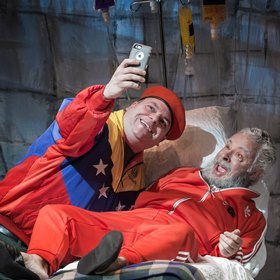
I never had trouble saying: Mi Málaga. I first went there during college, and never really left. At least in my mind. Venezuela, on the other hand, has been a more complicated love affair. Not being able to go on a regular basis combined with the political current at that moment never helped. Now, it is a frustrating relationship. How dramatically the land of my childhood is disintegrating from the seams. Both my parents agree it is not a good time to visit. My rational side completely understands. Physically, I look Venezuelan, but my accent is a blend of Andalusian and Venezuelan. Plus my American dress code and mentality give clear signs that President Maduro is not my biggest fan. Indeed red is one of my favorite colors, but not there.
It is sad how politics permeates even what should be a light-hearted conversation on literature and soap operas, one of the Venezuela´s main pastimes. Recently, I went to hear author Alberto Barrera give a talk at the King Juan Carlos Center. He has an interesting career writing books and soap opera stories as well as a weekly column for El Nacional (the main opposition newspaper). The author, so cool and diplomatic, did not want to dig too deep into the oficialismo. When a journalist from another Venezuelan newspaper asked, all he said was he was not censored, and it seemed true from a few of his articles I read online. Barrera is lucky. Is it because he lives in Mexico City? I could not help but wonder.
When I found out that he was going to speak at NYU, I sent my dad a Whatsapp message, and asked him if I should go. He said yes. He was well known and a good writer. Honestly, I did not know much about Barrera, but was glad I went. My two bookcases have several books on Venezuelan art and politics, and felt lucky to have found a compilation of short stories. I read his before the talk, and afterwards asked him to dedicate it. A little cheesy. Maybe. Most, if not all of the intimate crowd there that evening, seemed to be from Venezuela or have an affinity toward the country. It was very heart-warming to hear stories that I could totally relate to even though I have not lived there in twenty-plus years.
Growing up in Caracas, we watched soap operas. That was the normal thing to do. One of my favorites was Cristal with Jeanette Rodriguez and Carlos Mata. Even my maternal grandmother was hooked. Months after her visit from New York and with little to no Spanish in her vocabulary, she still asked my mom how Cristal was doing. Cristal had become part of the family. My mom´s feminist side was always amazed how the female protagonists in any soap opera always had perfect hair, make-up, and nails even when they were rolling out of bed.
Barrera reminded us that realism was never the point. Could this hyper-reality help explain magic realism in literature? I am sure a dissertation or two have been written about this. When I lived in Spain, I was told that I looked and sounded like the Venezuelan soap opera stars that for many years appeared on TV. It must have been my long dark hair and big eyes. I would always chuckle because melodrama was far from my everyday life. For years, I secretly hoped that my parent's separation had a more dramatic reason, but it never did.
My drama today is thinking of the next time I will see my grandmother. Doña Fausta, as she is known in town, is our family matriarch. All of seven her siblings have passed on. This October is special because, God willing, she will celebrate her 100th birthday! Every time we talk, I remind her that we will see each other then, all the time praying that I can keep my end of the bargain. My father, for reasons I will probably never know, is her favorite, but my deep connection with her is purely physical. Out of my thirteen cousins, I am the one who looks most like her. But don´t tell them I said that.
My dad keeps saying the country is going to “explode” but so far, the regime keeps finding new issues to bring oxygen to its lackluster government. Sixteen years of socialism, and it is still going albeit not as strong as in the beginning. Recently, I was reminded of Chavez´s deep infatuation with Fidel in Hierba Mala Nunca Muere, currently playing at Repertorio Español. Spoiler alert: Castro´s character outmaneuvers his would-be assassins even when he is in the hospital with a failing mind (see image above). I am just amazed how he has outlasted eleven US presidents, and still counting. As the title implies, bad seeds never die.
On a lighter note, a few Sundays ago, I went to see pianist Luis Perdomo play at Teatro Pregones in the Bronx. One of the pieces that I most felt in my gut was a joropo, Venezuela´s national dance music. Traditionally played with the harp, cuatro (four string guitar) and maracas, he did a beautiful rendition using solely the piano. Perdomo also played pieces of his latest CD titled 22. Twenty-two years ago he left our beloved Venezuela. As of this year, he has lived as much time away as here in the US. In short: Un pie aquí y otro allá or one foot here, another there.
My equation looks a little different. Most recently, I have lived the same number of years in New York as an adult as all my time in Spain. Venezuela is still the winner by a few years. Until then, I will continue to enjoy injections of Venezuelan culture here in New York City until I find my next destination takes over.
Photo: Michael Palma
2 notes
·
View notes
Text
The Label
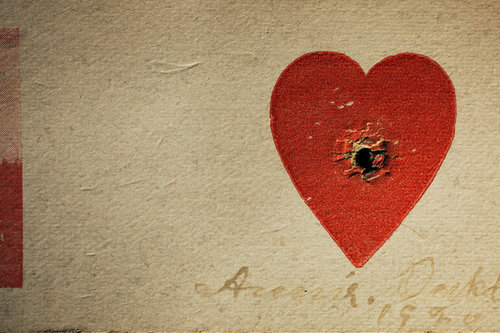
I was so looking forward to the Annie Leibovitz show at the New York Historical Society. Used to seeing her montages of beautiful Hollywood stars in Vanity Fair, I was finally going to see her work in person. In short, I was finally going to eat my delicious gluten-free chocolate chip cookie, but the cookie turned out to be hard and stale…
¨Pilgrimage¨ as the title of the show implies was a very personal project. She visited places of interest throughout the country over a two-year period. The design was also unique, as it had no individualized labels for each of the photographs. This was the first time I had ever encountered this, and it left me a little bewildered. Thankfully, a pamphlet provided some basic information. But I found this both annoying and distracting; I was paying more attention to the reading instead of the photographs in front of me. When I did look up, the pictures seemed lifeless. Perhaps, that was the point since all of the images were items that once belonged to Thomas Jefferson, Annie Oakley, Ansel Adams, among others. At one point I overhead another visitor say, ¨le magnifique¨. Really? Were they that magnificent? I had totally missed the boat. For me, it was: le disappointment. When I asked Michael, a professional photographer, what he thought, he also agreed with me. Luckily, we both missed the boat!
Soon after, that feeling turned into melancholy when we walked down to the ground level to see another exhibit at the Historical Society called Chinese-Americans: Exclusion-Inclusion. I could only get through half of the show. I wanted to cry. For all that the Liebovitz exhibit lacked in aiding the visitor to better understanding why Annie had chosen those particular artifacts to photograph, this show was a sensory overload. It was actually preachy to the point of being suffocating. It chronicled the history of American diplomacy and policy towards China and later Chinese-Americans in the US, not our finest moments as the beacons of democracy in the world. It was a sad reminder of how yet another immigrant group was discriminated against through legal and not so legal means. The closing as well as the mural heading towards the gift shop was mildly uplifting with personalities who rose above adversity.
Although I am not a curator, I am a proud museum junkie. I have been to enough exhibits and worked with artists to appreciate the strengths and weaknesses shows can have. I commend the Historical Society for offering a varied selection of shows. In this case, a super star that will attract a crowd along with a show that deals with an important community in New York from a not so pretty perspective. The diametric contrast in these two exhibits left me thinking yet again on the main role of museums/cultural institutions. The Annie show had more a salon look and feel that made the experience more personal while the Chinese one was more pedagogical. What about a ¨third-way¨ of making it look effortless with enough of a framework (anything from full to partial label, audio guide, catalog) to leave the visitor curious and wanting to learn more, like a good kiss. Otherwise, why bother?
Image: NYT Annie Oakley´s broken heart.
0 notes
Text
Mi Venezuela
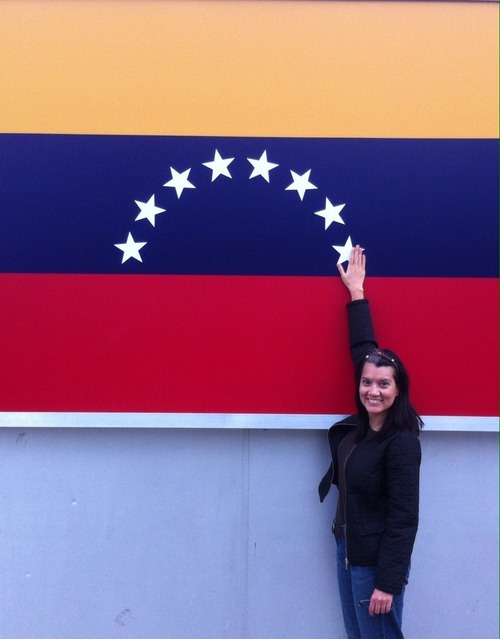
I was looking forward to checking out the Marisol exhibit at El Museo del Barrio ever since it opened a few months ago. Anything about Venezuela, the land of my childhood, always draws me in, more so, if it is a museum that promotes Latin-American art.
As I walked through the show, I kept thinking what made Marisol Venezuelan, and what could connect us given that we are both living in New York City for some time. But for some reason, I never really found it. Unluckily, there was no detailed text in the show, unless it is in the catalogue, to connect her work with the art movements in Venezuela or Latin America. We did find out that she was part of the New York scene and was pals with Andy Warhol! One of her sculptures had the colors of the Venezuelan flag (yellow, blue and red), but that was pretty much it. I did, however, relate to her work as a feminist artist as she delved into such themes as family, eroticism and gender violence. Sadly, I felt that her pieces represented work by a contemporary female artist whose nationality was irrelevant. Perhaps that was not something she considered important; for me, my bi-cultural upbringing will always be part of how I identify myself.
Several weeks earlier, Michael and I had gone to see a few films that were part of the Venezuelan Film Festival. It felt like a true welcome home. My favorite film was ¨Papitas, Maní, Tostón¨ (chips, peanuts and fried plantains); three snacks sold during baseball games. The Romeo-Juliet plot pinned star-crossed baseball fans whose loyalty was akin to the NY Yankees vs. Boston Red Socks. Besides being a charming romantic-comedy, it was also nostalgic as the grandfather of the protagonist is a well-known actor whom I remember watching on the TV show ¨Bienvenidos¨ with my dad. My ultimate feel-good moment though came when the couple faced a beautiful night panorama of Caracas as the coqui-like sound was heard in the background.
All of the films reminded me of the fun-loving Venezuelan; full of life, helping the other, but also ¨el sinverguenza¨ or the rascal. Unfortunately, the panel I attended diverged from Venezuela’s film industry today to a screaming match between Chavistas vs. Anti-Chavistas. It brought back a bitter taste left during one of my last visits when I decided it was safer not to discuss politics with some family members who actually believe Chavez’s legacy is all positive. My only option is to lament with the other side of the family who don’t think that, and believe that blind adoration towards Cuba’s government is not a good thing at all. My takeaway is that Hugo Chavez started off with good intentions, but corruption and power got the best of him and now his successor, Nicolás Maduro.
In the end, I came back to the notion of identity. I have long lost my Venezuelan citizenship not out of choice, but mere practicality. It is easier to travel with a US passport (although with the state of world affairs I’m left wondering if that is still the case…). That however is not a statement of how I feel; I will always consider myself a Venezuelan-American. So anything I can do or see that brings me back to my childhood will always add a smile to my day.
Image taken by Michael outside the Tribeca Cinema where the festival took place. I am covering one of the stars of the Venezuelan flag. Growing up, it had 7 stars. Then, Chavez came, and added one.
1 note
·
View note
Text
The One and Only: Louis Armstrong
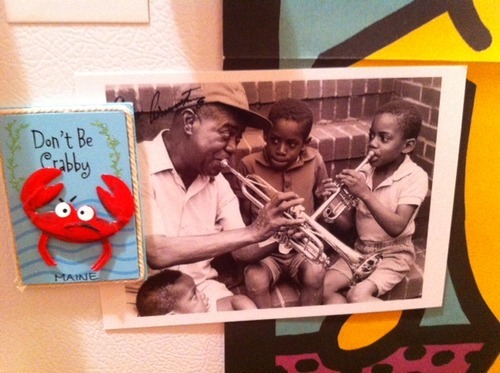
Ever since I discovered it, I wanted to include Jazz at Lincoln Center on my list of venues to frequent, but its unfriendly prices stopped me. So when I got an email offering a generous discount for a jazz appreciation class there, I could not resist. For a few years now, I have taken art classes as my way to deal with my winter blues; my last one had been portrait drawing in the Lower East Side. Now it was time to take one further uptown, and a little closer to home.
My expertise on jazz, if you can call it that, amounted to a few concerts here and there along with a couple of television shows and documentaries. My nerdy side told me to start from the very beginning with Jazz 101. To my delight, it worked out perfectly because the class had a great mix of backgrounds and ages along with a self-effacing teacher and composer who was eager to share his know-how.
Even though I learned a lot, I often got lost. Counting the beat of a song was difficult. Math was never my favorite subject except for algebra with Ms. Johnson way back in junior high school. Trying to follow a beat and count was too much. Instead, I decided to create more descriptive titles or phrases to songs as a way of giving the beat some texture. Here are two examples: 1) I Found a New Baby featuring Sidney Bechet on sax (Sept 15, 1932) became ¨a crazy teenager driving a mustang in a drag race,¨ and 2) Dizzy Spells with the Benny Goodman Quartet (Jan 16, 1936) simply became ¨Psychedelic Spells¨. Then, to top things off, we had a teacher’s pet who would ask such technical questions that my eyes would roll until I discovered she was an opera singer!
One of my favorites sessions was on Afro-Cuban jazz. For me it happily coincided with the screening of ¨Celia¨at El Museo del Barrio. Although she is considered a salsa icon, I think her early music could be considered Afro-Cuban jazz. The film was a reminder of what a classy lady Celia was. She broke the glass ceiling regarding gender and race in music with great charm and talent. She is perhaps better known for saying ¨azucar¨or sugar in Spanish, but she could out-sing and out-dance anyone on stage, which was thrilling to see in live footage.
A few weeks later, my boyfriend Michael and I saw the Afro-Latin Jazz Orchestra Band headed by Arturo O’Farrill at Symphony Space. It was another fabulous experience of watching the fusion of jazz with Latin American sounds and rhythms. It was a celebration of life. I was high on happiness, and so was the rest of the audience.
However, what made me connect all the dots from the class was the pilgrimage, we made to the house-museum of legendary trumpet player and singer Louis Armstrong. Although he traveled most of the year, a modest house in Corona, Queens was his home for several decades. The inside was left just as when he and his wife Lucille had it with the added bonus that he had saved his own recordings, so we got to hear him talk and play as we ventured through different parts of the house, including the bathroom!
This very American art form is also universal. So, whether it is a jazz or jazz-fusion or classic jazz, it reminds us all that ¨It’s a Wonderful World¨! And Louie said it best: https://www.youtube.com/watch?v=E2VCwBzGdPM
Image: postcard purchased at the Museum. The magnet is a gentle reminder that I can´t be crabby if Louis is playing.
1 note
·
View note
Text
Not What I Expected...
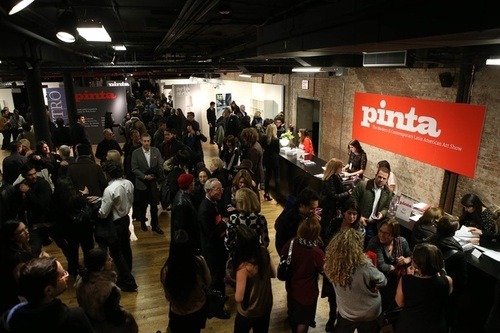
I was so excited to finally make it to PINTA, THE modern and contemporary Latin American art show in New York City. Sadly, it turned out to be a big disappointment. It seemed to be the place to see and be seen. Lots of beautiful people along with plastic surgery and botox. In other words, lots of fakeness. I was reminded of a recent New York Times article on beauty and Venezuela. We pride ourselves in having one Miss Universe after another. Since the pageant began in the 1950´s, we have had seven, second after the United States (this according to Wikipedia). But outer beauty comes at a cost. Plastic surgery.
Anyway, I think what was probably bothering me even more than the fake beauty was feeling self-conscious about being by myself. I reverted to my early childhood trait; my almost painful shyness that kicked-in every time I went to a new place and did not know anyone. That night, I would have done anything to have been with one of my friends or a family member although not many like to go with me to museums or galleries. I read EVERYTHING, and it takes me forever just to get through a gallery let alone an entire exhibit!
So I tried to focus on the artwork in search of something exciting and perhaps new material for my blog. Nothing really grabbed me except for two pieces that offered lots of sentimental value. Both artists were from my beloved Venezuela. One was a clear descendent of Jesus Soto and kinetic art with three-dimensional wall installations made of wire, glass and plastic. None of the pieces were extra-ordinary, but they were still nice enough. The other was a collage of contact sheets with images of Caracas, where I spent my early childhood, based on a book titled ¨The Horrible Caracas¨. Such an odd title required more information. So I asked my dad to see if he could get me a copy. So far it has proven to be a hard endevour because the book was a limited edition.
Ironically, a few moments before, I had seen fellow Venezuelan and curator of visual arts, Gabriela Rangel. For some reason, I froze. Nothing witty, funny or smart came to mind. Saying that I was happily at my job promoting artists and arts organizations seemed a little cheesy. When I finally knocked some sense into myself, she was no where to be found.
So I promised myself that I would shake off my returned shyness, and mingle at a satellite show by one of our artists. Even though it was a quick walk, it felt miles away. The energy was fun and fresh. Lots of beautiful men, a female drummer keeping everyone smiling and free Pellegrino water. Unluckily for me, the wine had long gone!
As the saying goes, no man is an island. Or as my mom likes to say: life is all about relationships. At the second location of the evening, I felt differently because I knew people there, and could mingle and feel at ease. In the end, we want to go where everyone knows our name… But having meaningful and fun conversations is what makes an event memorable. Several days later, I read another article about the ¨art of good conversation” and how we are losing it thanks to technology. Now that my job involves lots of get-togethers, I am reminded that good conversation is an art-form. As my friends know, I am always up for a glamorous event, but being a homey is just fine too particularly when there is good conversation.
Image: artforbes.com
1 note
·
View note
Text
Puerto Rico: Isla del Encanto

Never in a million years did I think I would want a trip in order to vegetate. I am known to be a compulsive trip planner to the point of exhausting my travel companions and myself all with the goal of seeing EVERYTHING. Forget smelling the roses: you can do that when you get back!
So when the opportunity came up, my mom and I jumped at the idea of visiting Puerto Rico and staying at a house near the beach. All I wanted for this adventure involved lots of sun and beach, and to return to New York’s fall weather with a fabulous tan. A little shallow- I know- but I’m not a fan of looking pale!
Luckily or not, my magic plan only came to partial fruition. We rented a car, and it proved to be a little more stressful than I would have liked. In the end, it was probably a combination of not driving much and the poor road signs. Refusing to use a friend’s GPS was not one of my brightest ideas.
Driving around the main island, we were struck by the poverty. Was this really the US? Yes, it is an American Commonwealth, although I prefer ¨estado libre asociado¨or free associated state as it is called in Spanish. I started thinking of all of the courses in politics and literature I had taken years ago for my major in International Studies (my concentration was in Latin America). As American citizens, Puerto Ricans have many rights but… they can’t vote in national elections, for example. They can serve in the army - many have bravely fought and died in all major wars of the 20th century. The contradictions go on and on, and the statistics are even more striking: 45% of the population in the island lives in poverty.*
My friend Angie suggested the documentary ¨Yo Soy Boricua Pa´Que Tu Lo Sepas¨ (I am Puerto Rican, Just So you Know) directed by and starring the one and only Rosie Perez. It was both funny and bittersweet because it brought back the anger and frustration of all the US has done in its own backyard including secret testing of uranium and agent orange, as well as carrying out a sterilization law, among other atrocities.
So, why is Puerto Rico called the Enchanted Island, as its car plates declare? One guess is the natural beauty. As my mom and I hiked through El Yunque, an amazing tropical rainforest, we heard the famous coqui, a singing tree frog that literally chants the word “co-ki”. Another side-trip included a 1.5-hour ferry ride to the island of Culebra (snake in Spanish) and seasickness was well worth it. It was one of the most beautiful beaches I have ever been to (along with Los Roques in Venezuela). However, besides the aqua-colored water and cream-colored sand, a US tank was also part of the scenery. This tiny island along with the island of Vieques were both US military bases for many years. Thankfully they are mostly today nature reserves.
On our way back, I started thinking of all the Puerto Rican flags that I have seen in New York, particularly during the Puerto Rican Day Parade. All of a sudden it made sense that national pride is so visible here. I decided to dig deeper, and interview a few Puerto Rican friends. Everyone offered lots of food for thought, so much so that a blog entry would not do it justice.
I would like to tie-it up by saying that what Aníbal said most intrigued me. He claimed that the time of the Puerto Ricans has passed because other groups are surpassing them, meaning that other Latino communities are rapidly growing and taking their share of the American pie. Overall, I think this is a good thing. But how can we as Latinos in America, and as a united front, continue to build momentum and wake-up the ¨Sleeping Giant¨ (as we are referred) while honoring the American tradition of being the melting pot of the world? Let me get back to you after I have some more coquito... It´s a Puerto Rican eggnog-like drink with coconut and rum. Yum!
Did you know? Here are a few fun facts:
Puerto Rico is an archipelago
The main island was originally called San Juan and the capital Puerto Rico. The names were then inverted.
The Puerto Rican flag was designed in New York
*http://www.census.gov/prod/2011pubs/acsbr10-01.pdf
Image: Playa Flamenco in Island of Culebra, PR
4 notes
·
View notes
Text
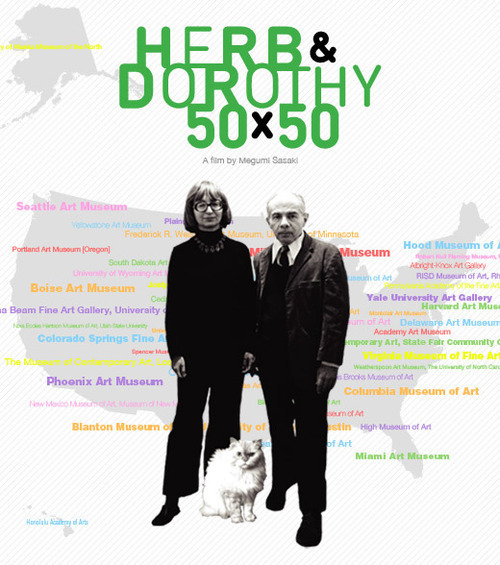
A few weeks ago I saw the sequel to Herb and Dorothy. I had missed the first documentary when it came out in theaters, and promised myself that I would not let it happen again. Thankfully one of my electronic journals gave me enough warning so I could happily plan an outing with my friend Prasun that included a gluten-free dinner and a screening at the IFC, a cute and intimate theater in the Village. Part II is titled 50x50 (http://vogel5050.org) because it refers to Dorothy and Herb’s donation of 50 artworks from their collection to each of the 50 states. There was so much to go around, that they agreed to spread the love across the country! Amazing.
After paying for the tickets, I noticed that our screening had a Q and A; but never in a million years did I think that I would meet both the director, Megumi Sasaki and Dorothy Vogel! In my first blog about the Vogel’s (See blog titled The love of life), I promised to go to the National Gallery of Art (Washington, D.C.) and see their collection. I learned months later that it is scattered throughout the museum; they do not have a Vogel Gallery, as many collectors seem to have in New York museums.
As I watched the film, it got me thinking that their story was truly an American story; two civil servants with modest means that built a fabulous collection of contemporary and minimalist art only to give it all away. For all I love Spain, I feel that this story could not have been told there. In general terms, the European philosophy regarding the arts is that the state is the main torchbearer, so private citizens don’t feel obligated to facilitate in the collecting and bequeathing of pieces to museums. Could it be an ego-thing of having your name in a gallery, building or museum? I am sure altruism has a role to play. To what extent is another story. But for the Vogel’s there was something else going on, as Dorothy reminded us while answering questions from the audience, she and Herb truly enjoyed meeting and becoming friends with many of the artists whose works they collected. Going to gallery openings and studios was something fun, and not just something to do.
What also makes this story universal? To me, the love the Vogel’s had for what they did. Tears streamed down my cheeks as I saw Megumi walk in with Dorothy, who now uses a cane. I was annoyed at myself for not bringing a pad and a pen; I had wanted to take excellent notes to soak everything in (this was and continues to be one of my favorite parts of being a student; taking notes).
In the end it was not so much about watching part II, rather seeing them in person, taking a picture with Dorothy, and being reminded that we are here to do what we love. Why do anything else?
Image taken from the documentary website.
#Herb and Dorothy#New York#IFC#Megumi Sasaki#contemporary art#minimalist art#National Gallery of Art
1 note
·
View note
Text
Fairness in Art?!
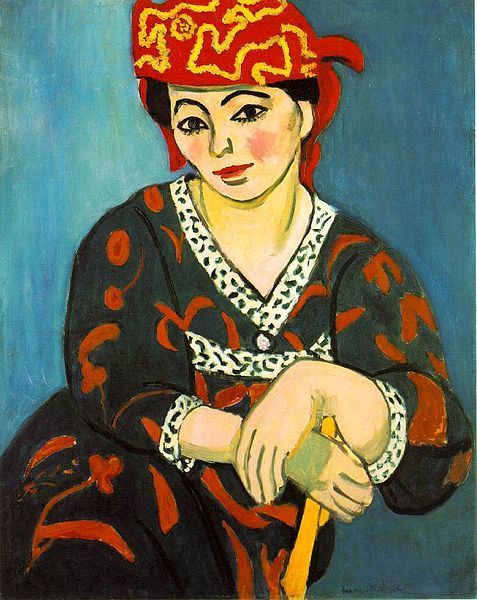
A few months back my mom and I saw ¨The Art of the Steal; ¨ a documentary on the story behind the Barnes Collection. Even though there was no blood or violence, it was one of the most upsetting films I have seen in a while.
The story goes that after Dr. Albert Barnes became a self-made millionaire, he decided to spend his time, energy and money in learning as well as in collecting artworks. From 1911 until his sudden death in 1951, he amassed an incredible collection that rivals any museum in the world, and that today is worth 25 billion dollars. Yes, you read right: 25 billion dollars according to the documentary. Although it focuses on the old school classics including: Renoir (181), Cezanne (69), Matisse (59), Picasso (46), among others, it is still breathtaking.
What makes this collection unique? Two elements: the arrangement of the pieces and the fact that it was moved against the wishes of the original owner. Each room has paintings as well as arts and crafts that share elements of light, line, color and space. For example, one ¨ensemble¨ as Barnes called each arrangement, has two masque-like portraits by Picasso alongside a cabinet filled with African head sculptures while the rest of the room offers paintings by Rousseau and Matisse (more on one of his paintings further down), among other artists, who created work ¨away¨ from home. Here you can see how artists influenced each other, but how they also borrowed from everyday objects found in other cultures. Barnes wanted to show continuity of artistic tradition and practice across cultures and generations. Today this set-up is considered organic with a very intuitive look and feel. Back then it challenged the conventional way of displaying art by chronology, nationality and style.
The Barnes Collection had until recently a beautiful home surrounded by a 12-acre arboretum in Lower Marion, PA. After his death, and through a series of ill-fated turns, the trust he created was broken, and his collection moved to a newly constructed museum in downtown Philadelphia. The powers that be including high-level politicians and elites within the city’s establishment claimed that the foundation was bankrupt and that the only way to preserve the collection was to move it to a more desirable location. Was it cultural vandalism or perhaps a conspiracy as the documentary claims? I am not sure what to call it, but my blood boils every time I think of what happened.
After watching the documentary, we decided to make a pilgrimage to see the collection in its new home. Right before entering, I got a sharp pain in my chest when I saw: ¨Walter and Leonore Annenberg Court¨. I remembered that Barnes despised the Annenberg’s along with the oligarchs who ran the city. He was quoted as saying: Philadelphia is a depressing intellectual slum. Thankfully, the pain quickly subsided. As I walked through the galleries, I was mesmerized. How could one man have the energy and pockets to buy and arrange so much art? I felt privileged to see it in person.
All along, I have claimed that the main goal of my blog is to look at the intersection of arts and politics. The Barnes Collection is the perfect example, and maybe that is why it turned out to be one of the hardest entries to write, and it has become one of the longest so far! In this case, the politicians have a new cultural gem they hope will turn the Ben Franklin Parkway into another High Line (one of New York City´s darling attractions) and the foundations have secured a priceless collection all while breaking the wishes of the creator of the collection. Lesson learnt: in the war of art and politics, politics more often than not is the clear winner.
On a happier note, I had the privilege of interviewing one of the students who studied at the Barnes. Cathy had very sweet memories of her time there, and it was incredibly fascinating to hear about it. What struck me most was the lifelong visual appreciation she received thanks to the Barnes, and how it has continued to be part of her and her husband’s way of creating art and enjoying life.
To that end, I wanted to share one of my favorite pieces in the collection titled ¨Madras Rouge¨ by Matisse (see image above). It is not your typical portrait because the sitter is very casual in her pose and attire. Even though her face has a mask-like quality, the vibrant colors along with the thick contour lines offer the viewer lots to think about. The other half of the enjoyment is doing a comparison and contrast with other pieces in the ensemble!
Life is not always fair; fair is a weather report. That is what Mr. Lewis, my high school English teacher, used to say whenever we complained. If you ever go to Philadelphia, the city of brotherly love, love the art but not the politics. Deal?
Image Of Madras Rouge taken from Wikipedia.
3 notes
·
View notes
Text
Ephemeral Art
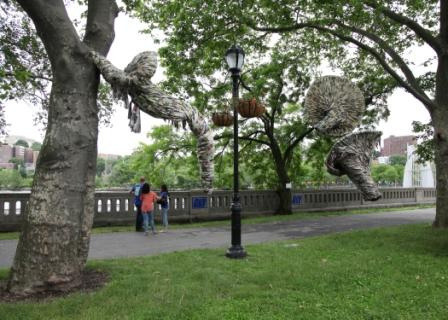
What is ¨ephemeral art¨? Basically, art that is meant to exist for a short period of time. At the end of May, we did a call for artists to present ¨ephemeral art¨ projects that would be displayed at Sherman Creek-Swindler Cove, a park in northern Manhattan. Besides the sand castle making we all did when we were kids, I was reminded of two experiences I had had with this type of art.
During my senior year of college, two Tibetan monks spent a week painting a large beautiful and colorful mandala in our school gallery. I went on the last day, and almost cried as one of them swept it all away in a matter of seconds. Why not leave it a few more days? I guess that was not the point. The point was to let go or that was the lesson I got out of it. I have always had trouble letting go, just ask my parents!
A few years later, I visited one of my mom’s dear friends in Venezuela. She showed me a little bunny I had made for her with plastilina (play-doh). Even back then, I was obsessed with permanence; I had poured a ton of Elmer’s glue to my art piece so it would last for a while. That it did! She had had it for at least 20 years.
So when we received the ephemeral submissions, I was pleasantly surprised to see such different and creative proposals that were not meant to last a lifetime. They included a whimsical unicorn sign, gigantic paper mâché tornado-like structures that were literally glued to a tree, colorful tree trunk benches, and super-tall chairs that looked out into the horizon, among others. What I did not expect was that some of these pieces would get vandalized. When my colleague and I contacted the artists, they were not thrilled, but they took it as part of the deal for displaying their creations in a public park. For me, it was terribly disappointing. One thing was the weather, but to purposely destroy an art piece was totally mean spirited.
Yesterday, as I watched the evening news, I found out that the Lincoln Memorial as well as a chapel in the National Cathedral, both in Washington, D.C., had been vandalized with green paint. A woman was arrested, but not much more was known. I guess there are not-so-nice people everywhere. I still believe there are many more people out there who are moved by art, and do not have the urge to damage it.
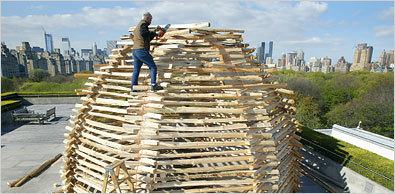
Recently, I saw a very slow moving yet powerful documentary titled “Rivers and Tides” that shows the ephemeral artist Andy Goldsworthy in action. I was very touched by his intuitive way of creating. There is almost a religious aspect to his work as he tries to understand the energy of nature using leaves, ice, branches, and stone as integral parts of his art. Examples include a flower chain left on a flowing riverbed and ice pieces glued together to form a sculpture on top of a rock right as the sun is melting it. Unlike a diamond, ephemeral art is not meant to be forever. Maybe that is ok.
Tornados by Erin Turner. Image taken by Gary Santana.
Andy Goldsworthy @ The Roof of the Met, NYC
0 notes
Text
My Real ¨Wyn¨ Moment
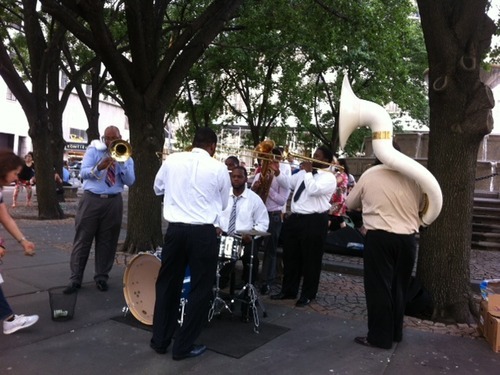
My first star-struck moment, and what do I do? I basically start drooling. Definitely not my most glamorous moment. I have met a few celebrities, and to be honest, never been terribly impressed. But meeting the trumpet player and Artistic Director of Jazz at Lincoln Center, Wynton Marsalis, was my Justin Bieber moment! (No offense to Bieber fans) Ever since I discovered jazz several blue moons ago, it had been one of my goals to meet him.
Through one of the groups where I volunteer, ELNYA (Emerging Leaders of New York Arts), I was able to get reduced tickets to see Wynton perform, along with the possibility of meeting him after the concert. I immediately jumped at the opportunity without realizing what I was signing-up to see. Basically it was jazz performance led by conductor Alan Gilbert with his New York Philharmonic crew as well as Wynton´s band. When I sat in my seat, I was far too nervous and excited to read the program. As each of the six movements were played, I was transported to different time periods and places that had influenced jazz. My only disappointment was not enjoying it at a speakeasy or smoky jazz bar with a glass of my favorite wines from Ribera de Duero. Avery Fischer Hall was a little too formal for me.
Afterwards, our group was escorted to the green room where Mr. Marsalis was waiting for us. When I greeted him, all that came out were monosyllables. Thankfully, he was gracious enough to return my intellectual hindrance with a smile. After he made us all feel at ease, he opened the chat to a Q and A that lasted close to one hour! It was then that I decided to redeem myself. My first question was to ask him what he thought of Ken Burns´ PBS series called ¨Jazz” to which he answered that he talked one day to Ken, and all the rest is history (Wynton was one of the artistic advisors for the series). He regretted, though, that there was not enough jazz music of the early period. Then, I asked him about Tremé, the HBO series set in New Orleans (his hometown) following Katrina. I have enjoyed renting seasons one and two, and look forward to season three. One night I did a Tremé marathon, and watched 7 episodes back to back. The episodes offer terrific music with powerful storylines that seem all too real. Again and to my surprise, he felt that it focused too much on the hippies and not enough on the everyday people. As he answered other questions from my arts administrator colleagues, I was blown away by his sense of community. His words of wisdom were: embrace people whatever you do.
A few days later, I saw a group of musicians playing across the street from the Apple Store on 5th Ave. A parade had passed by hours before, and I assumed they had been part of it. I started thinking about their impromptu performance. Was this group catering to the tourists or were they for real? All I knew is that they started playing with ¨When the Saints Come Marching In,¨ then moved to swing and then something more modern. At one point, two girls started dancing and another guy started bopping his head. Soon enough the band and the crowd were embracing one another. I think this would have made Wynton proud!
1 note
·
View note
Text
My New 'Hood
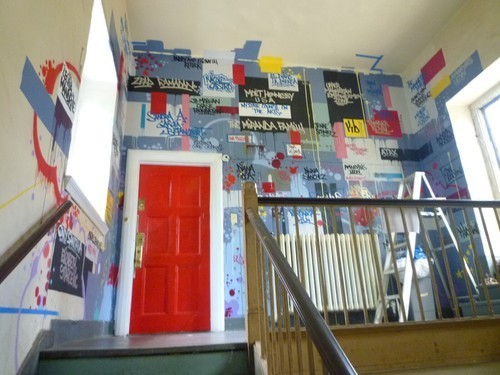
When I first saw ¨Style Wars” 9 years ago, this famously fabulous documentary on graffiti in New York offered me a great visual to understanding this art form. Just as important, it was also a great history lesson on the intersection of art and politics, one of the main interests in my blog.
In 2004, I had recently moved to Madrid, and Inma, one of my dear friends, had come to visit from my beloved Málaga. I had a feeling she would enjoy seeing the documentary at La Casa Encendida, a cultural center known for its funky and alternative programming, and located at the foot of a truly hipster neighborhood called Lavapiés. Indeed, we both enjoyed it, but it felt very far removed from our lives then.
Fast forward to 2013. I work in a non-profit that promotes artists and arts organizations in Washington Heights-Inwood, and interview two graffiti influenced visual artists about their upcoming exhibit in our gallery! After watching the documentary a second time, I was reminded how major stakeholders in the City including former Mayor Koch, cops, MTA officials and the artists had very different opinions on public art and its subversive element.
All of a sudden, I started to see connections; hip-hop is the other name for graffiti. I remembered the break dancers my mom loves to watch when we are taking the A train back to my apartment, and how they are descendents of the first wave of graffiti artists. I thought about local author Raquel Cepeda and how hip-hop permeates her novel ¨Bird of Paradise,” and how she would love a girl on the train who had neon blue high-top sneakers with wings on the sides.
One of the artists, who goes by FEEGZ, that I interviewed was commissioned to create a mural to celebrate our organization’s fifth anniversary. In memory of my sister, Nicole, I wanted her name on the wall. I know she is smiling knowing that I am doing something I enjoy and believe in; promoting artists in my new ´hood.
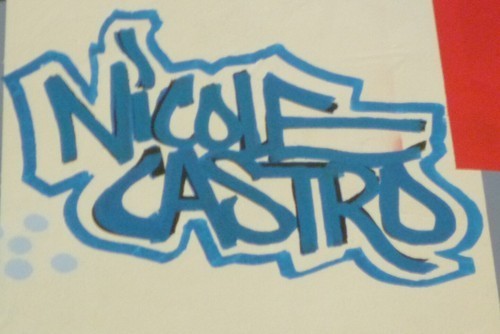
Top photo: mural in progress
Bottom photo: final design
2 notes
·
View notes
Text
Being in the Heights
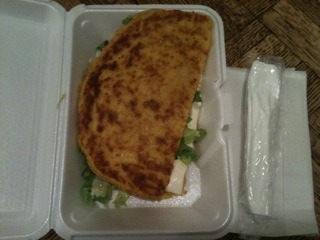
A few weeks ago I saw ¨In the Heights In Concert” which reunited the original cast after its last show five years ago. I had seen the Broadway musical when my friend, Desiree asked me to be her plus one along with a group of Latino Congressmen who were invited to attend the performance.
My friend Dez and I are dear college friends who also happen to be half-Latinas; her father is Chicano and mine Venezuelan. Our small liberal arts school was not very diverse when we were there (thankfully it has changed since then). Growing up in Washington, D.C, my school as well as my neighborhood resembled a mini-United Nations. So, one way of feeling “at home” during undergrad years was to reawaken a dormant Latin American Club by co-chairing it with her. Watching ¨In the Heights¨ was also a gentle reminder of the ¨Sleeping Giant,” a term coined well over a decade ago to describe the budding political-economic-social power of the Latino population in the United States. This was the first time a musical about, with and created by Latinos had made it to Broadway. We had made it! And in a positive light!
This time, when the concert started, it felt different. ¨In the Heights In Concert¨ was performed at the United Palace for the Arts in Washington Heights. And what a homecoming it was. It was the first time I have seen the entire audience (close to 3,400) establish a dialogue with the singers from the very beginning. The majority knew the lyrics, sang with, and at one point helped one of the singers who had forgotten her line. It was an awe-inspiring experience. Someone told me that the closest experience he had to this was a Bruce Springsteen concert, and I believe it.
This sense of belonging and ownership of part of my identity is felt most deeply when I speak in Spanish. Whether I go to the dollar store, dry-cleaners or a hardware store in my new neighborhood of Washington Heights-Inwood, I am greeted with “Cuídese mami¨ (take care, darling) ¨Buenos días, mi amor¨ (good morning, my love). At first, my feminist side would cringe. A colleague rightly pointed out that most often the male shopkeepers bellow these charming phrases. I only know that I am madly in love with my super, but he does not know it just yet. He calls me ¨mija” short for ¨mi hija¨or literally ¨my daughter.¨ It is also used as a sign of affection. I often say ¨hey mija¨ when I see Dez.
Today I accept all greetings with an inner smile. There are worse things. Plus they are usually pretty harmless. This use of Spanish on a daily basis also had me thinking: this is the first time I am speaking Spanish in my neighborhood since I lived in Spain, and I love it! An added bonus is discovering a Venezuelan restaurant within walking distance from my apartment. Last Friday, I ordered from “Cachapas y Más” a yummy cachapa or corn pancake. My northern Manhattan cachapa (see image above) brings back sweet memories of eating them at my grandmother’s house in Venezuela. Usually she or one of my aunts would make them from scratch with corn brought over from a farm of a cousin or friend. By the way, they are also great for those with gluten allergies like me. So all is especially good when the tummy is full!
1 note
·
View note